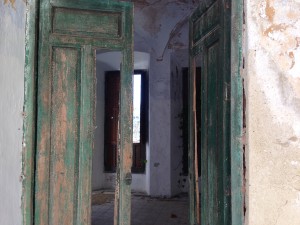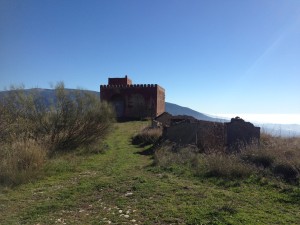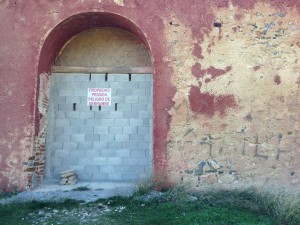The Last Moorish Princess of Andalusia…
High above the once Moorish and still whitewashed villages of Los Guajares on a remote pass that straddles the ancient high road to Granada there sit two separate old structures facing each other across a road. Both are falling into disrepair and signs warn of danger and not to enter. Locals need no such warning as they already steer clear of the ruins, the few four by fours that occasionally take this road, passing quickly, their drivers without desire to stop. You see, on certain nights it is said light can be seen pouring from the turret of the one windowless structure, accompanied by haunting sounds from deep within its belly. No one ventures here at night.
I find myself up here one day collecting wood for the fireplace, when I turn the last bend in the road and at the time unbeknown to me, come across the palace of the last Moorish Princess of Andalusia. This is her story…
Longer ago than any living person recalls, there resided high, high in the Guajares Mountains in Andalusia, Southern Spain in a place today known only to a few locals as Puerto Montana, a Moor and his beautiful daughter. They were perhaps, along with his daughter – so he thought – the very last of their kind in all of Andalusia. More than two centuries before his time, Granada, the last bastion of Moorish Spain, had fallen and it was therefore now eight generations since most of his surviving ancestors had returned across the Mediterranean to the coast of Africa from where they had originally come.
This Moor along with his aforementioned daughter lived on a cortijo so remote in the hills, so high above the white pueblos of Los Guajares that his presence had either not been noticed, forgotten, or in the best neighbourly spirit a solitary remaining Moor, and therefore technically enemy in Spain might hope for, tolerated. Where he lived, so very high up at precisely a pass where the eye stretches all the way from the majestic snow-capped high Sierra Nevada of the East to the mountains of his ancestral Africa peaking through the clouds to the South, the Moor on his cortijo had all he could wish for; pines for wood; land for sheep and goats which provided milk and when the time was right, meat; springs sprang forth spewing the very purest of clean, cold, fresh, mountain water and all this on land so far from where anyone desired to live that not a soul coveted it.
Now in order to blend in and thus not to risk the wrath of his fellow man, for he was a survivor of the 1568 Second Revolt of the Moors (more of that later) the great great grandfather of our Moor had decided to construct his new above to be the very epitome of whitewashed Andalusian cortijos, complete with green shutters, orange trees and flat rooftop terraces. Two centuries later, each night when there was no one around that could overhear, his ancestor had his muezzin (who also acted as a solitary servant) call out the Adhan from this terrace which for the purpose acted as a minaret; a praise he shared only with the wind that nightly sweeps the high plain. Other than this, he lived as did the people of the villages below. As modestly and as happily.
It was as such, in total idyllic and peaceful isolation that he had seen no need, as had his father and fathers’ father before him, ever to return to his native soil, other than of course to seek a bride when the time had been right. Here high above the sea, rising daily with the first sun and following it down each night he had all a man could ever desire. So only when something in his spirit felt his ancestors call him from beyond, that he must continue the bloodline, had he descended down along the mountain trails trod by so many sheep, through olive groves to the coast and the once splendid Moorish town of Salobrena, still graced high above by the walls of its ruined castle. Not particularly wishing to encounter anyone, he avoided the main square and headed directly for the beach. Here he sought out a fisherman whom he found mending his nets.
The old man, quietly going about his work, barely looked up as the Moor removed from his satchel the very purest of gold and offered a generous weight of it to take them both across the Sea to Melina. Without a word he merely nodded, rigged his boat ready for the journey and pushed off through the shallow waves to the great sea beyond. When later, they landed safely and without incident in Africa, the Moor promised the old man double the measure of gold to return and fetch him exactly one week later – the time he thought it would take to find a suitable bride – and as he counted on there being twice the cargo for the return journey, for he was confident in the success of his venture – this therefore seemed a fair price. The fisherman again nodded and headed back to sea.
Now as mentioned, an ancestor of the current solitary resident of the hill of Puerto Montana, had survived the time of the great purging of the ‘Moriscos’ as the Spanish then called them. Long after the last great King of Granada, Ez-Zaghal had been defeated, his kingdom now in the Alpujarras and reduced to such an extent it could no longer be called realm. Soon, they say his lost glory and present shame became too great for him to bear and he returned to Africa. He was greeted by the Sultan of Fez, blinded as punishment and lived out his days wandering and begging for food. Back in Andalusia, rebellion nevertheless continued to flare up. It was now three generations since Boabdil ‘The Unlucky’ Ez-Zagahl’s nephew had signed the act of capitulation and surrendered Granada.
As he had departed and reached the pass on the road to the coast, he is said to have looked back and sighed deeply at the beauty of his lost city of Granada. ‘El ultimo sospiro del Moro’ – the last sigh of the Moor – is still marked today on signs as one drives up the highway to Granada. During the last rebellion the Alpujarras with their high peaks, steep valleys, self sufficient villages and centuries of tradition had formed the base for the last resolute opponents of the Christians. After their eventual defeat, one survivor had fled across the Rio Guadalfeo, donned the breeches and hat of the locals, seemingly fulfilled the minimum religious duties imposed on them after 1526 by Holy Roman Emperor Charles V spurred on by the Inquisition, and founded the cortijo that forms the basis of this tale.
It would appear the only time our Moor used his noble ancestry (for he had documents tracing him in direct bloodline to Ez-Zaghal ‘The Valliant’) to his advantage, was in aiding him in finding a bride. For a week later, as promised, he, duly accompanied by a beautiful young equally noble woman, met the fisherman on the beach of Melina. The three of them crossed the Mediterranean, which once again behaved itself and the couple returned to their high cortijo.
Here the Moor hid the documents proving his ancestry away in the same chest of drawers in the innermost room from where he had fetched them and swore his wife to secrecy; never to reveal to their future children their noble ancestry (being a Moor, much less a noble one, in the hills of Andalusia in the 18th Century was not easy and he wanted to do so himself – possibly – when the time was right). In the end, this proved an unnecessary measure as his young wife died giving birth to their first child, a daughter. He buried his wife, cried and named their daughter Makar Rasa which means devoted to God.
As Makar Rasa grew up it soon became clear she had inherited the beauty of her mother. Yet, here in the hills of Andalusia it didn’t matter. She had only her father and his Muezzin for company and together the three of them lived a simple and happy existence. They tended their cortijo, looked after the orange trees, harvested olives in the late autumn and all was peaceful. Once a year, the Moor would take his daughter with him to Granada to the market. Here after making the few purchases they required, he would sit below the Alhambra on a low stone wall at a place where an old path leads up from the river below. Maker Rasa, though she was ignorant of the past that connected her to the splendour above, loved looking up and admiring the high walls, as her father told tales of such wonder from a time long ago. She thought anyone who lived in such a palace must surely be happiest on Earth. The Moor, to his end, always made sure never to reveal anything that might make his daughter guess at her heritage.
Like this they could have lived a lifetime, but… the inevitable happened. One day as Makar Rasa was carrying wood home for the fire, she met in the forest a shepherd just a few years older than her. Needless to say, he fell in love instantly. He moved his flock closer to her cortijo and stayed for a week, letting his sheep enjoy the high pastures. As they spent every day together, the old Moor looked on happily and approved.
He had long decided, perhaps scarred by the memory of his wife, that no more would they return to their homeland to seek to continue the bloodline. It made less and less sense to do so. They had all they needed here and he liked the shepherd. When the animals had exhausted the grass of Puerto Montana, the shepherd had no choice but to move on. It broke his heart to do so, but he sheered his finest sheep and made a present of the fleece to his love. With this along with a promise to return as soon as the grass could once more nourish his flock, he left very early one morning before dawn.
This carried on all throughout the summer. Whenever he could the shepherd returned and each time Makar Rasa was delighted to see him. Though in her heart she always felt abandoned when he left her and part of her was afraid of what might happen if one day he did not return. One time she even got angry and ordered him to leave, but she regretted her words – borne out of fear – and soon caught him up with his slow moving flock. As summer turned to autumn it seemed the perfect match and the couple, very much in love discussed and then asked permission from the old Moor for the shepherd to winter his sheep in the old disused barn of the cortijo.
Then one day everything changed. The shepherd had travelled away to the lower valleys as the winter was approaching. Another week or perhaps two and he would return and the wandering would be over for the season. Maker Rasa, bored, missing her love decided to clean the house in anticipation for his return for which she longed. She removed the summer curtains, wishing to replace them with the thick woollen winter ones and when she could not find them, she searched everywhere. And so it was that everywhere, as the word implies, eventually included the chest where her father had hid the secret of their past. He had taught his daughter well (the shepherd found her the most intelligent person he had ever met) and as she sat on the floor reading, her noble past was revealed to her; she was a princess.
It took a week for her to remove the shepherd from her life for the first time. After he had returned, he had at first been delighted by the news. It confirmed in him, as he had that traditional ‘peasant’ awe and respect for the noble classes, why it was she was so special. Other than this, he saw little reason for things to change. But it soon became obvious that to Makar Rasa, this was not the case. With each day she grew more and more distant and after they fought she dismissed the shepherd. She then went to her father and demanded that, as she was a princess, he construct for her a palace as became her station and please could he begin right this very moment.
And so it was that during the winter, when there was little to do on the cortijo, the palace of the Last Moorish Princess of Andalusia stone by stone was completed. Occasionally the shepherd would return, sometimes she would admit him, serve him tea and survey the construction together other times she refused to acknowledge him. Reluctantly her father, for he too loved his daughter, carried out her wish. And all the time, as the labours of the old Moor grew the walls higher and higher, his heart sank lower and lower as they did so.
Come spring, the Palace, a perfect red square, turret and windows looking out over the Sierra was complete. But the Princess was not content. She had realised she was different to the people of this land. Maybe she had always felt different. How can they understand me? she thought and so each week she had one window after another walled up. She decided there was nothing she wanted from the world outside and she had no desire to let it in. Perfect isolation was what she sought. She had her luxurious palace and from the outside had come only the lies of her father who had denied the truth from her and the common shepherd who least of all could be expected to understand a princess and all he would do anyway was to abandon her. And soon it happened – as math dictates it would (many windows, minus one each week) that there were no windows left. From across the mountain road, her father in his cortijo, looked on with sadness at this golden cage.
Several times, as often as he could, the shepherd returned with his flock. The Alpujarras are famous for witches and maybe, so he thought, one had strayed across the Guadalfeo and cast a curse for hew could not understand the transformation that had befallen his love. Each time he returned, he called to his Princess who did eventually once, one autumn, appear in her turret. His heart leapt, but he only saw her briefly as she threw him a letter.
Then she was gone.’Shepherd’, read the letter; ‘I hate you not and I like you not. I have no feelings for you. I do not want you in my life’. After this, despite never giving up hope, he never returned. What could he do? He carried on moving his flock through all of Andalusia. He never gave up hope that word would reach him one day from Puerto Montana, but as time passed, it became clear none would come. Not a day passed when he did not awake and consider turning his flock South to his princess, in case she still needed him. For the truth is in the short time he had known her love, he had been the happiest of his life. It seemed impossible to him that she could not feel the same and so though he spent most of his time missing the love of Makar Rasa and hoping to hear from her, as he did truly love her and wanted her happiness, he also wished she had managed to escape her cage, a cage that he could not understand and found a Prince to love…
After that, the truth is no one knows what became of the Moor, his beautiful daughter or the shepherd. The bloodline of course died out – at least there at Puerto Montana and the two buildings; the cortijo and the palace became boarded up, deemed unsafe.
Today the strange sounds and the light which they say sometimes emerge from the palace are all that remain to remind us of the Last Moorish Princess of Andalusia.
– The End
The Last Moorish Princess of Andalusia I must confess, if you haven’t already guessed, is entirely made up. I was indeed up here in the hills one day collecting wood when I did in fact turn the corner in the road and came across the spectacle of these two old ruins facing each other. Of the two, I was immediately fascinated by the moorish looking building; red, square, totally isolated and entirely windowless. I walked around and around the ‘palace’ and thought; ‘why on earth no windows?’ (I couldn’t think it could be a real harem here). I kept wondering who lived here once; and so this unique structure became the inspiration for this story. The Moors did inhabit the hills surrounding Granada long after the city itself fell to the Christians and indeed my village Guajar Alto, appears once to have been a home to some of the very last, but the Princess in her tower, well if she ever existed, then it is just a coincidence.
However this one strange building inspired me and I love a good yarn so, as I always carry my notebook and pencil with me, after taking a few photos and exploring as much as I could, I sat down and came up with the tale you have just read…
Now my new home, not ten miles from Puerto Montana, also has a ‘turret’. When I climb up there evening at each sunset to enjoy the view, if I look down the valley and up at the hills to the East, I can almost make out the pass just over the ridge, where the Last Princess was born in my imagination. I might never discover the secret of that red building, why it was built or who inhabited it, but it is nice to dream…












I was waiting for you to tell us you have a new tour ready for us to sign up. Thanks for your story…had me fooled until I realized you were having fun. Hope you had a wonderful Christmas holiday…maybe a trip back to see your folks? Karl and I leave Jan 7th for the month in NZ-Australia so will be having more adventures with Road Scholar. Hope to see you next August. I will email you our plans and see where you are at that time. Best wishes for 2015 and many many more miles to travel. Hope you are settled in your new home and enjoying it! Martie and Karl – Tucson
Hey Martie and Karl – thanks guys for the read as always… Glad I fibbed you 😉 Did pop back to the UK for Xmas, but every happy to be back home now again… Enjoy ‘down under’ – I am sure you will love it! Let me know after… August is good for me so hope to see you back in the somewhat less exotic – Luton… Happy travels
Hi Thomas, Lovely story, had me completely fooled, even to the extent of looking for the book on Amazon. Nevertheless, a lovely story that I got completely immersed in.
I trust that you are well and getting set for another season of escorting tour groups?
Live long and prosper
Hola Colin (and cats) – wow yours is truly one of the best complements I’ve ever had on my blog I think. My friend, thank you really very much for reading – it means so much that people do. Hope you had a good time in Oz… All well here in Spain – ten days till a new season starts (hmm where did that off-season go?)… Hugs to you from G A 😉
[…] is another story the inspiration for which came to me in an instant, much like that of the Last Moorish Princess of Andalusia. When visiting Granada (now only an hour from where I live) I never fail to take the old path up to […]
The Sultan's Bathwater - 2ndcupoftea 2ndcupoftea said this on January 24, 2015 at 11:47 am |
Isn’t this spot amazing? Back 15 years ago there were a few of the beautiful interior tiles left. Is that the case now? I fear they were plundered.
Yes I love this place 😉 Thanks for reading… Didn’t notice the tiles – fear they have gone… Such an atmospheric spot. I wonder if I’ll ever know it’s true story… Casa Nu a very happy place – THANK YOU 😉